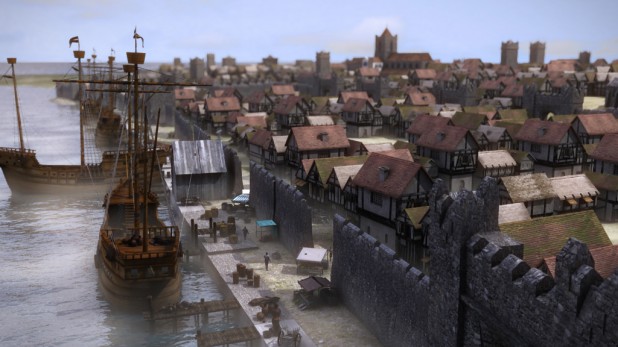
In 1209, the owners of buildings upon the river Liffey were granted a license from King John, to erect edifices which became known as the “Quays”. There are many references to buildings on the bank of the river, in the parishes of St. Michael and St. Audoen. In the thirteenth century, ships unloaded part of their cargo in Dalkey and the remainder at the “Crane”, which was located at the northern end of Winetavern Street. The Crane was used as the Dublin Custom House for a long period of time. On the 11th March 1596, a quantity of gunpowder which was unloaded at the Crane exploded, causing great destruction and loss of life. During the latter part of the reign of James Ist, a new Custom House, crane and wharf was erected. In 1644, Thomas Hill, craner and wharfinger, leased the old Custom House at a rent of five pounds. The Old Crane was rebuilt and was used as a storehouse.
During the 16th and 17th centuries, Merchant’s Quay had several landing places or “slips” as they were known. In 1560, troops and ammunition sent from England, to wage war against Shane O’Neill, landed at the Crane. In 1643, a widow named Catherine Duff, was “tenant to the city” of all the slips of Merchant and Wood Quays. She was obliged to repair and maintain all the slips and walls of these quays, for which she would receive the sum of four pence, from every boat and vessel owner who used these quays. In 1654, a Vintner named Rees Phillips, is recorded as having leased all the slips of Merchant and Wood Quays for twenty one years, at an annual rent of three pounds.
Wood Quay extended from the Crane at the end of Winetavern Street to a building, Buttevant’s Tower. In the 16th century, Buttevant’s Tower was described as an old, square, ruined tower, with one vault. The wall was four feet thick and thirty feet high. This tower was later known as “Newman’s Tower” named after Jacob Newman, Clerk of the Rolls Office of the Chancery Court, who resided on Wood Quay. Nearby stood a small tower known as Casey’s Tower. It later became the Hall of the Guild of Bakers and its name was changed to Baker’s Tower. This tower was demolished in 1753.
In the Quay wall, at the southern end of Fishamble Street, Fyan’s Castle was located. The owners of this castle were important people in 15th and 16th century Dublin. John Fyan was Mayor in 1472 and 1479. Thomas Fyan was Sheriff in 1640. Subsequently, the castle was acquired by a merchant called George Proudfoot in the latter part of the 17th century and became known as Proudfoot Castle. In the reign of Charles 2nd Proudfoot Castle was occasionally used as a State prison.
There was a large pile of buildings at the west of Ormond Bridge, called Pudding Row. These and other unsightly buildings caused the passage to Winetavern Street to be very narrow and were finally removed around 1821. The Quay walls were then rebuilt. Ormond Bridge itself, was swept away in a flood in the year 1802 and was replaced by a new bridge named Richmond Bridge. It was formally opened to the public in 1816.








